Factors Affecting Student Engagement in Higher Education
VerifiedAdded on 2020/10/22
|11
|2746
|71
AI Summary
The provided document is an extensive compilation of research studies and articles on the topic of student engagement in higher education. It includes a wide range of sources from 2013 to 2018, covering various aspects such as motivation, self-determination, and terms of engagement. The document aims to provide a comprehensive understanding of factors influencing student engagement and promoting student engagement in today's classroom.
Contribute Materials
Your contribution can guide someone’s learning journey. Share your
documents today.

LITERATURE
REVIEW
REVIEW
Secure Best Marks with AI Grader
Need help grading? Try our AI Grader for instant feedback on your assignments.
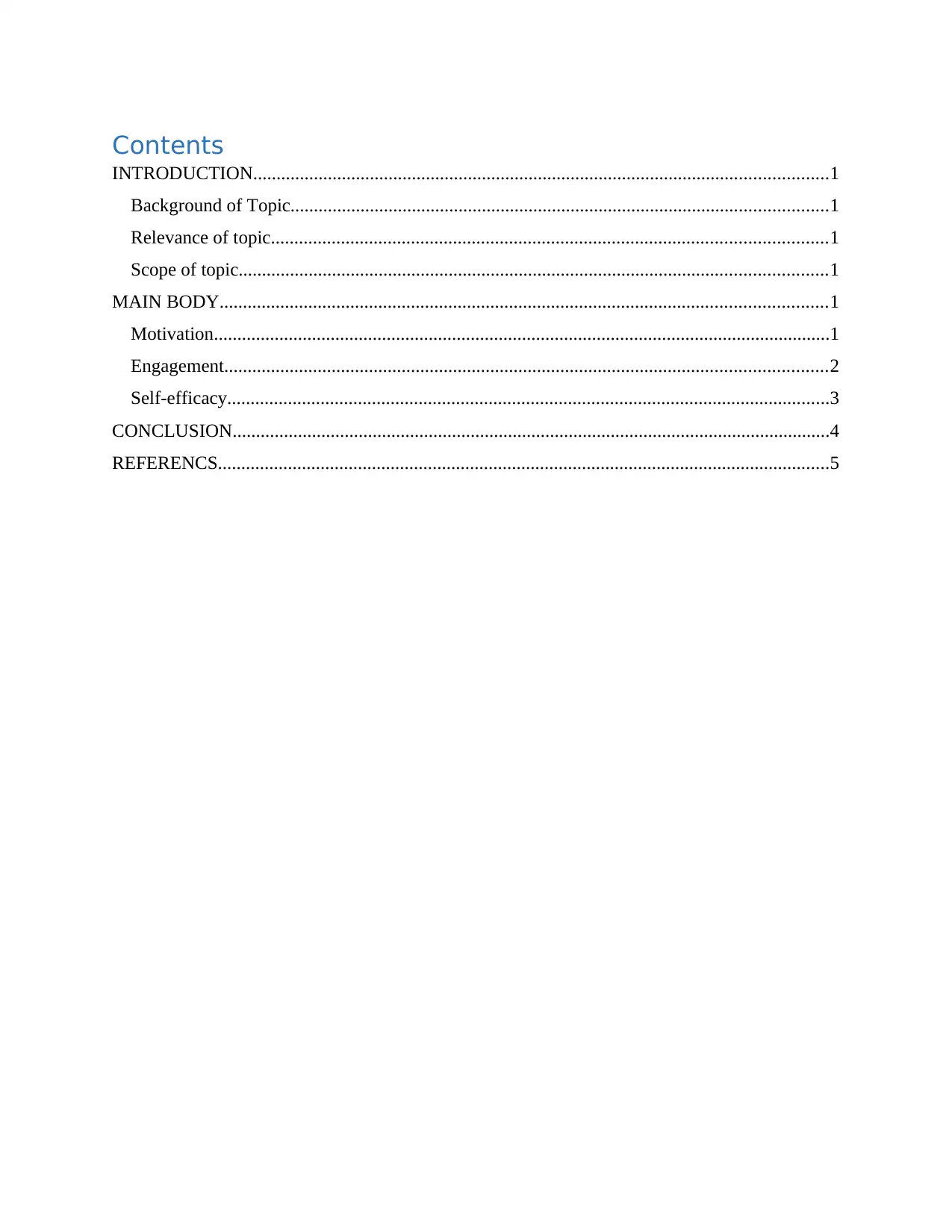
Contents
INTRODUCTION...........................................................................................................................1
Background of Topic...................................................................................................................1
Relevance of topic.......................................................................................................................1
Scope of topic..............................................................................................................................1
MAIN BODY..................................................................................................................................1
Motivation....................................................................................................................................1
Engagement.................................................................................................................................2
Self-efficacy.................................................................................................................................3
CONCLUSION................................................................................................................................4
REFERENCS...................................................................................................................................5
INTRODUCTION...........................................................................................................................1
Background of Topic...................................................................................................................1
Relevance of topic.......................................................................................................................1
Scope of topic..............................................................................................................................1
MAIN BODY..................................................................................................................................1
Motivation....................................................................................................................................1
Engagement.................................................................................................................................2
Self-efficacy.................................................................................................................................3
CONCLUSION................................................................................................................................4
REFERENCS...................................................................................................................................5
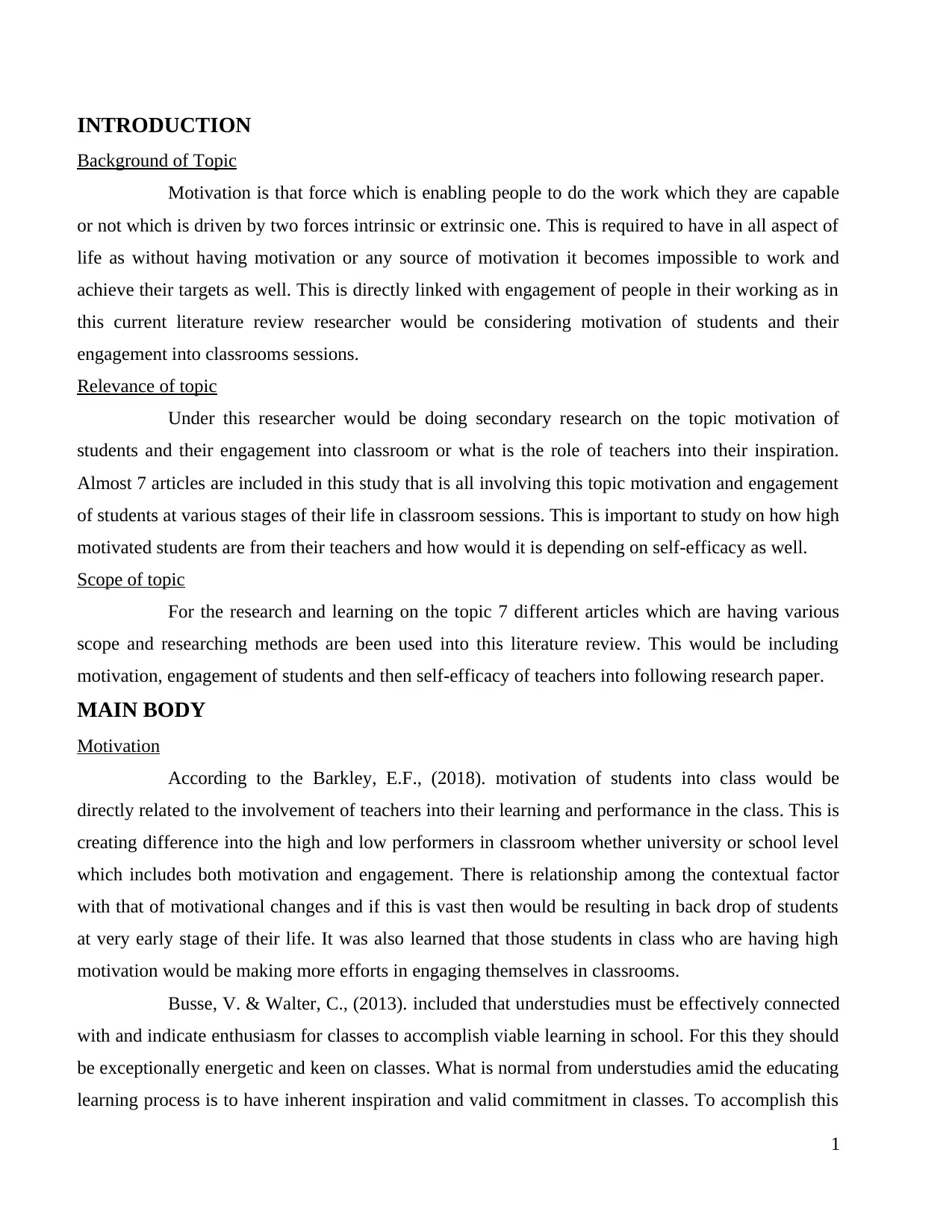
INTRODUCTION
Background of Topic
Motivation is that force which is enabling people to do the work which they are capable
or not which is driven by two forces intrinsic or extrinsic one. This is required to have in all aspect of
life as without having motivation or any source of motivation it becomes impossible to work and
achieve their targets as well. This is directly linked with engagement of people in their working as in
this current literature review researcher would be considering motivation of students and their
engagement into classrooms sessions.
Relevance of topic
Under this researcher would be doing secondary research on the topic motivation of
students and their engagement into classroom or what is the role of teachers into their inspiration.
Almost 7 articles are included in this study that is all involving this topic motivation and engagement
of students at various stages of their life in classroom sessions. This is important to study on how high
motivated students are from their teachers and how would it is depending on self-efficacy as well.
Scope of topic
For the research and learning on the topic 7 different articles which are having various
scope and researching methods are been used into this literature review. This would be including
motivation, engagement of students and then self-efficacy of teachers into following research paper.
MAIN BODY
Motivation
According to the Barkley, E.F., (2018). motivation of students into class would be
directly related to the involvement of teachers into their learning and performance in the class. This is
creating difference into the high and low performers in classroom whether university or school level
which includes both motivation and engagement. There is relationship among the contextual factor
with that of motivational changes and if this is vast then would be resulting in back drop of students
at very early stage of their life. It was also learned that those students in class who are having high
motivation would be making more efforts in engaging themselves in classrooms.
Busse, V. & Walter, C., (2013). included that understudies must be effectively connected
with and indicate enthusiasm for classes to accomplish viable learning in school. For this they should
be exceptionally energetic and keen on classes. What is normal from understudies amid the educating
learning process is to have inherent inspiration and valid commitment in classes. To accomplish this
1
Background of Topic
Motivation is that force which is enabling people to do the work which they are capable
or not which is driven by two forces intrinsic or extrinsic one. This is required to have in all aspect of
life as without having motivation or any source of motivation it becomes impossible to work and
achieve their targets as well. This is directly linked with engagement of people in their working as in
this current literature review researcher would be considering motivation of students and their
engagement into classrooms sessions.
Relevance of topic
Under this researcher would be doing secondary research on the topic motivation of
students and their engagement into classroom or what is the role of teachers into their inspiration.
Almost 7 articles are included in this study that is all involving this topic motivation and engagement
of students at various stages of their life in classroom sessions. This is important to study on how high
motivated students are from their teachers and how would it is depending on self-efficacy as well.
Scope of topic
For the research and learning on the topic 7 different articles which are having various
scope and researching methods are been used into this literature review. This would be including
motivation, engagement of students and then self-efficacy of teachers into following research paper.
MAIN BODY
Motivation
According to the Barkley, E.F., (2018). motivation of students into class would be
directly related to the involvement of teachers into their learning and performance in the class. This is
creating difference into the high and low performers in classroom whether university or school level
which includes both motivation and engagement. There is relationship among the contextual factor
with that of motivational changes and if this is vast then would be resulting in back drop of students
at very early stage of their life. It was also learned that those students in class who are having high
motivation would be making more efforts in engaging themselves in classrooms.
Busse, V. & Walter, C., (2013). included that understudies must be effectively connected
with and indicate enthusiasm for classes to accomplish viable learning in school. For this they should
be exceptionally energetic and keen on classes. What is normal from understudies amid the educating
learning process is to have inherent inspiration and valid commitment in classes. To accomplish this
1
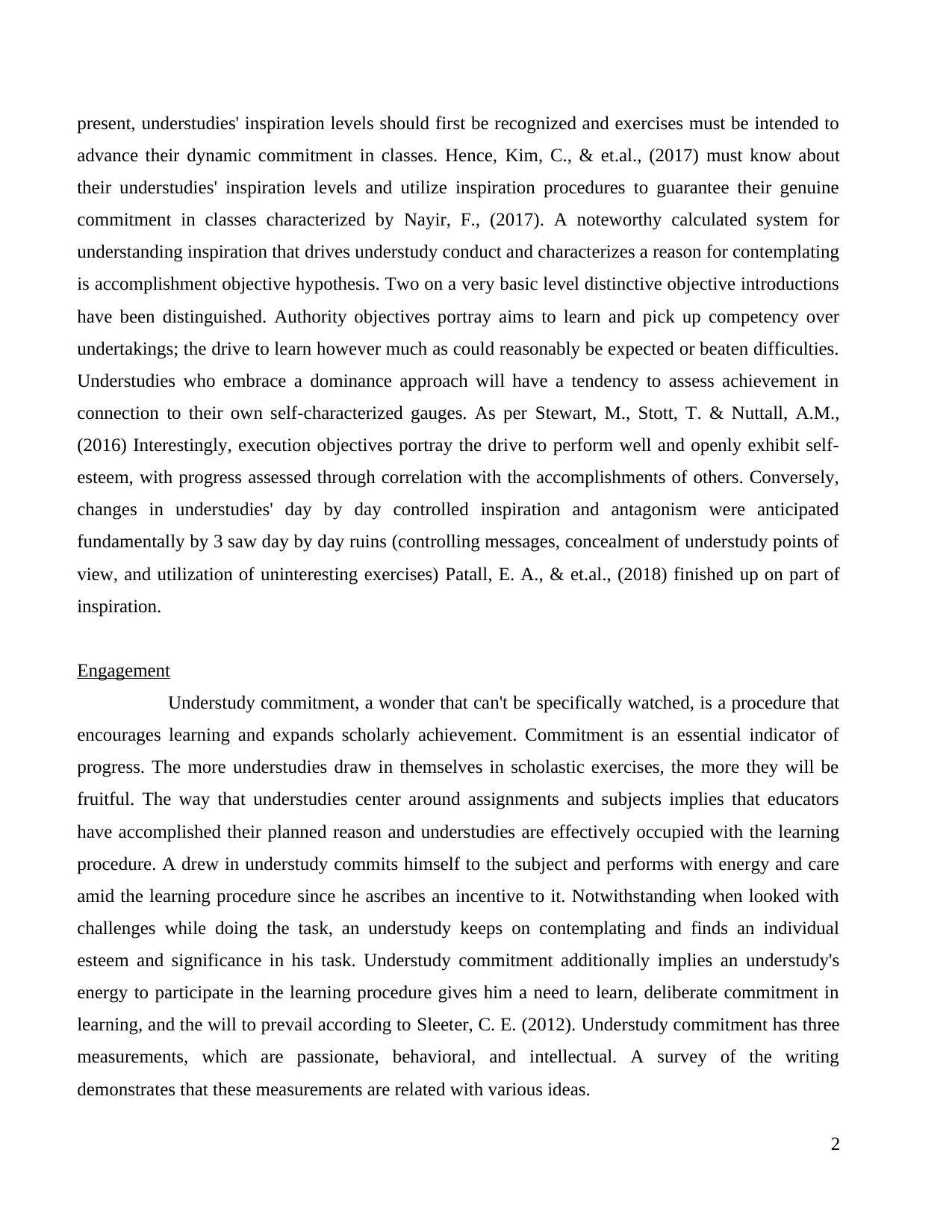
present, understudies' inspiration levels should first be recognized and exercises must be intended to
advance their dynamic commitment in classes. Hence, Kim, C., & et.al., (2017) must know about
their understudies' inspiration levels and utilize inspiration procedures to guarantee their genuine
commitment in classes characterized by Nayir, F., (2017). A noteworthy calculated system for
understanding inspiration that drives understudy conduct and characterizes a reason for contemplating
is accomplishment objective hypothesis. Two on a very basic level distinctive objective introductions
have been distinguished. Authority objectives portray aims to learn and pick up competency over
undertakings; the drive to learn however much as could reasonably be expected or beaten difficulties.
Understudies who embrace a dominance approach will have a tendency to assess achievement in
connection to their own self-characterized gauges. As per Stewart, M., Stott, T. & Nuttall, A.M.,
(2016) Interestingly, execution objectives portray the drive to perform well and openly exhibit self-
esteem, with progress assessed through correlation with the accomplishments of others. Conversely,
changes in understudies' day by day controlled inspiration and antagonism were anticipated
fundamentally by 3 saw day by day ruins (controlling messages, concealment of understudy points of
view, and utilization of uninteresting exercises) Patall, E. A., & et.al., (2018) finished up on part of
inspiration.
Engagement
Understudy commitment, a wonder that can't be specifically watched, is a procedure that
encourages learning and expands scholarly achievement. Commitment is an essential indicator of
progress. The more understudies draw in themselves in scholastic exercises, the more they will be
fruitful. The way that understudies center around assignments and subjects implies that educators
have accomplished their planned reason and understudies are effectively occupied with the learning
procedure. A drew in understudy commits himself to the subject and performs with energy and care
amid the learning procedure since he ascribes an incentive to it. Notwithstanding when looked with
challenges while doing the task, an understudy keeps on contemplating and finds an individual
esteem and significance in his task. Understudy commitment additionally implies an understudy's
energy to participate in the learning procedure gives him a need to learn, deliberate commitment in
learning, and the will to prevail according to Sleeter, C. E. (2012). Understudy commitment has three
measurements, which are passionate, behavioral, and intellectual. A survey of the writing
demonstrates that these measurements are related with various ideas.
2
advance their dynamic commitment in classes. Hence, Kim, C., & et.al., (2017) must know about
their understudies' inspiration levels and utilize inspiration procedures to guarantee their genuine
commitment in classes characterized by Nayir, F., (2017). A noteworthy calculated system for
understanding inspiration that drives understudy conduct and characterizes a reason for contemplating
is accomplishment objective hypothesis. Two on a very basic level distinctive objective introductions
have been distinguished. Authority objectives portray aims to learn and pick up competency over
undertakings; the drive to learn however much as could reasonably be expected or beaten difficulties.
Understudies who embrace a dominance approach will have a tendency to assess achievement in
connection to their own self-characterized gauges. As per Stewart, M., Stott, T. & Nuttall, A.M.,
(2016) Interestingly, execution objectives portray the drive to perform well and openly exhibit self-
esteem, with progress assessed through correlation with the accomplishments of others. Conversely,
changes in understudies' day by day controlled inspiration and antagonism were anticipated
fundamentally by 3 saw day by day ruins (controlling messages, concealment of understudy points of
view, and utilization of uninteresting exercises) Patall, E. A., & et.al., (2018) finished up on part of
inspiration.
Engagement
Understudy commitment, a wonder that can't be specifically watched, is a procedure that
encourages learning and expands scholarly achievement. Commitment is an essential indicator of
progress. The more understudies draw in themselves in scholastic exercises, the more they will be
fruitful. The way that understudies center around assignments and subjects implies that educators
have accomplished their planned reason and understudies are effectively occupied with the learning
procedure. A drew in understudy commits himself to the subject and performs with energy and care
amid the learning procedure since he ascribes an incentive to it. Notwithstanding when looked with
challenges while doing the task, an understudy keeps on contemplating and finds an individual
esteem and significance in his task. Understudy commitment additionally implies an understudy's
energy to participate in the learning procedure gives him a need to learn, deliberate commitment in
learning, and the will to prevail according to Sleeter, C. E. (2012). Understudy commitment has three
measurements, which are passionate, behavioral, and intellectual. A survey of the writing
demonstrates that these measurements are related with various ideas.
2
Secure Best Marks with AI Grader
Need help grading? Try our AI Grader for instant feedback on your assignments.
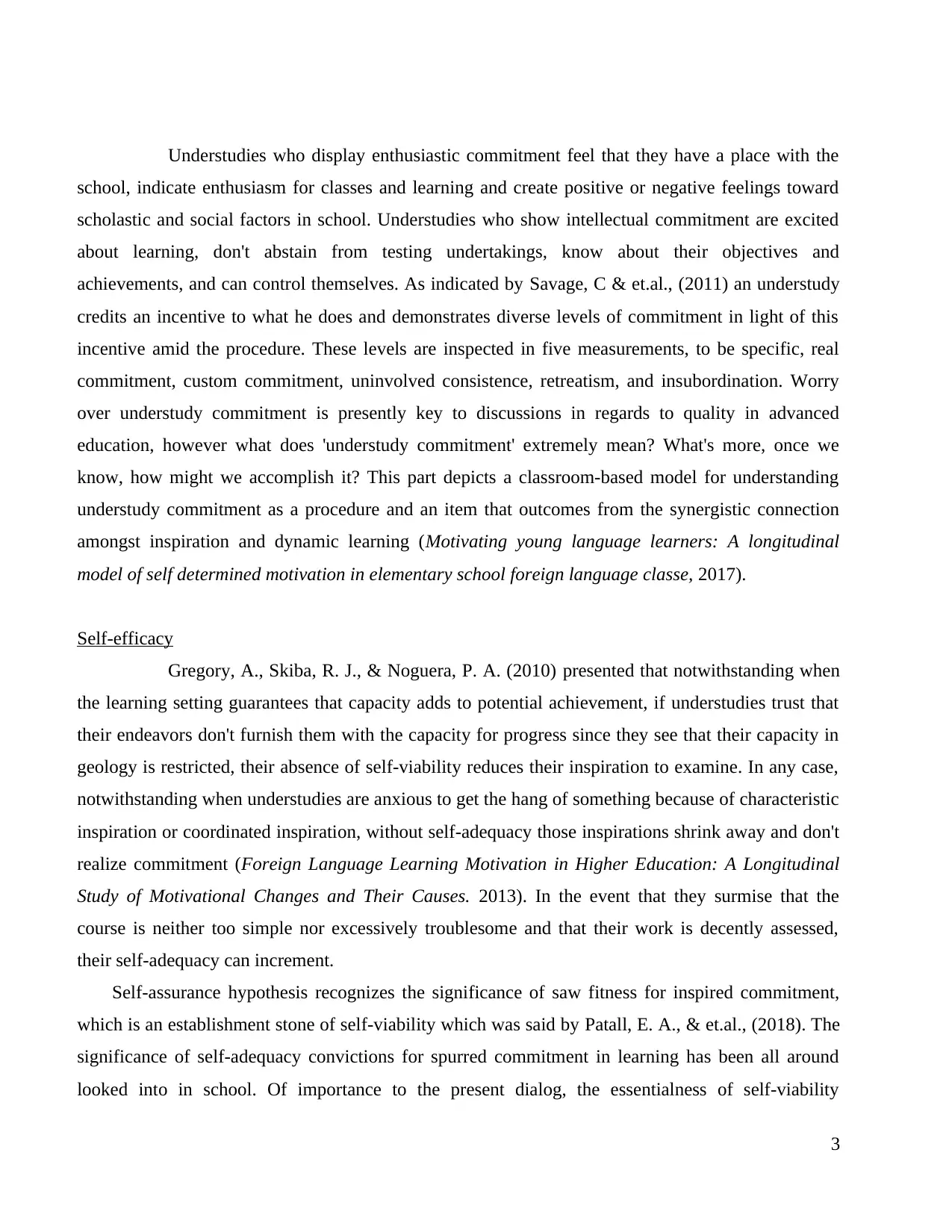
Understudies who display enthusiastic commitment feel that they have a place with the
school, indicate enthusiasm for classes and learning and create positive or negative feelings toward
scholastic and social factors in school. Understudies who show intellectual commitment are excited
about learning, don't abstain from testing undertakings, know about their objectives and
achievements, and can control themselves. As indicated by Savage, C & et.al., (2011) an understudy
credits an incentive to what he does and demonstrates diverse levels of commitment in light of this
incentive amid the procedure. These levels are inspected in five measurements, to be specific, real
commitment, custom commitment, uninvolved consistence, retreatism, and insubordination. Worry
over understudy commitment is presently key to discussions in regards to quality in advanced
education, however what does 'understudy commitment' extremely mean? What's more, once we
know, how might we accomplish it? This part depicts a classroom-based model for understanding
understudy commitment as a procedure and an item that outcomes from the synergistic connection
amongst inspiration and dynamic learning (Motivating young language learners: A longitudinal
model of self determined motivation in elementary school foreign language classe, 2017).
Self-efficacy
Gregory, A., Skiba, R. J., & Noguera, P. A. (2010) presented that notwithstanding when
the learning setting guarantees that capacity adds to potential achievement, if understudies trust that
their endeavors don't furnish them with the capacity for progress since they see that their capacity in
geology is restricted, their absence of self-viability reduces their inspiration to examine. In any case,
notwithstanding when understudies are anxious to get the hang of something because of characteristic
inspiration or coordinated inspiration, without self-adequacy those inspirations shrink away and don't
realize commitment (Foreign Language Learning Motivation in Higher Education: A Longitudinal
Study of Motivational Changes and Their Causes. 2013). In the event that they surmise that the
course is neither too simple nor excessively troublesome and that their work is decently assessed,
their self-adequacy can increment.
Self-assurance hypothesis recognizes the significance of saw fitness for inspired commitment,
which is an establishment stone of self-viability which was said by Patall, E. A., & et.al., (2018). The
significance of self-adequacy convictions for spurred commitment in learning has been all around
looked into in school. Of importance to the present dialog, the essentialness of self-viability
3
school, indicate enthusiasm for classes and learning and create positive or negative feelings toward
scholastic and social factors in school. Understudies who show intellectual commitment are excited
about learning, don't abstain from testing undertakings, know about their objectives and
achievements, and can control themselves. As indicated by Savage, C & et.al., (2011) an understudy
credits an incentive to what he does and demonstrates diverse levels of commitment in light of this
incentive amid the procedure. These levels are inspected in five measurements, to be specific, real
commitment, custom commitment, uninvolved consistence, retreatism, and insubordination. Worry
over understudy commitment is presently key to discussions in regards to quality in advanced
education, however what does 'understudy commitment' extremely mean? What's more, once we
know, how might we accomplish it? This part depicts a classroom-based model for understanding
understudy commitment as a procedure and an item that outcomes from the synergistic connection
amongst inspiration and dynamic learning (Motivating young language learners: A longitudinal
model of self determined motivation in elementary school foreign language classe, 2017).
Self-efficacy
Gregory, A., Skiba, R. J., & Noguera, P. A. (2010) presented that notwithstanding when
the learning setting guarantees that capacity adds to potential achievement, if understudies trust that
their endeavors don't furnish them with the capacity for progress since they see that their capacity in
geology is restricted, their absence of self-viability reduces their inspiration to examine. In any case,
notwithstanding when understudies are anxious to get the hang of something because of characteristic
inspiration or coordinated inspiration, without self-adequacy those inspirations shrink away and don't
realize commitment (Foreign Language Learning Motivation in Higher Education: A Longitudinal
Study of Motivational Changes and Their Causes. 2013). In the event that they surmise that the
course is neither too simple nor excessively troublesome and that their work is decently assessed,
their self-adequacy can increment.
Self-assurance hypothesis recognizes the significance of saw fitness for inspired commitment,
which is an establishment stone of self-viability which was said by Patall, E. A., & et.al., (2018). The
significance of self-adequacy convictions for spurred commitment in learning has been all around
looked into in school. Of importance to the present dialog, the essentialness of self-viability
3
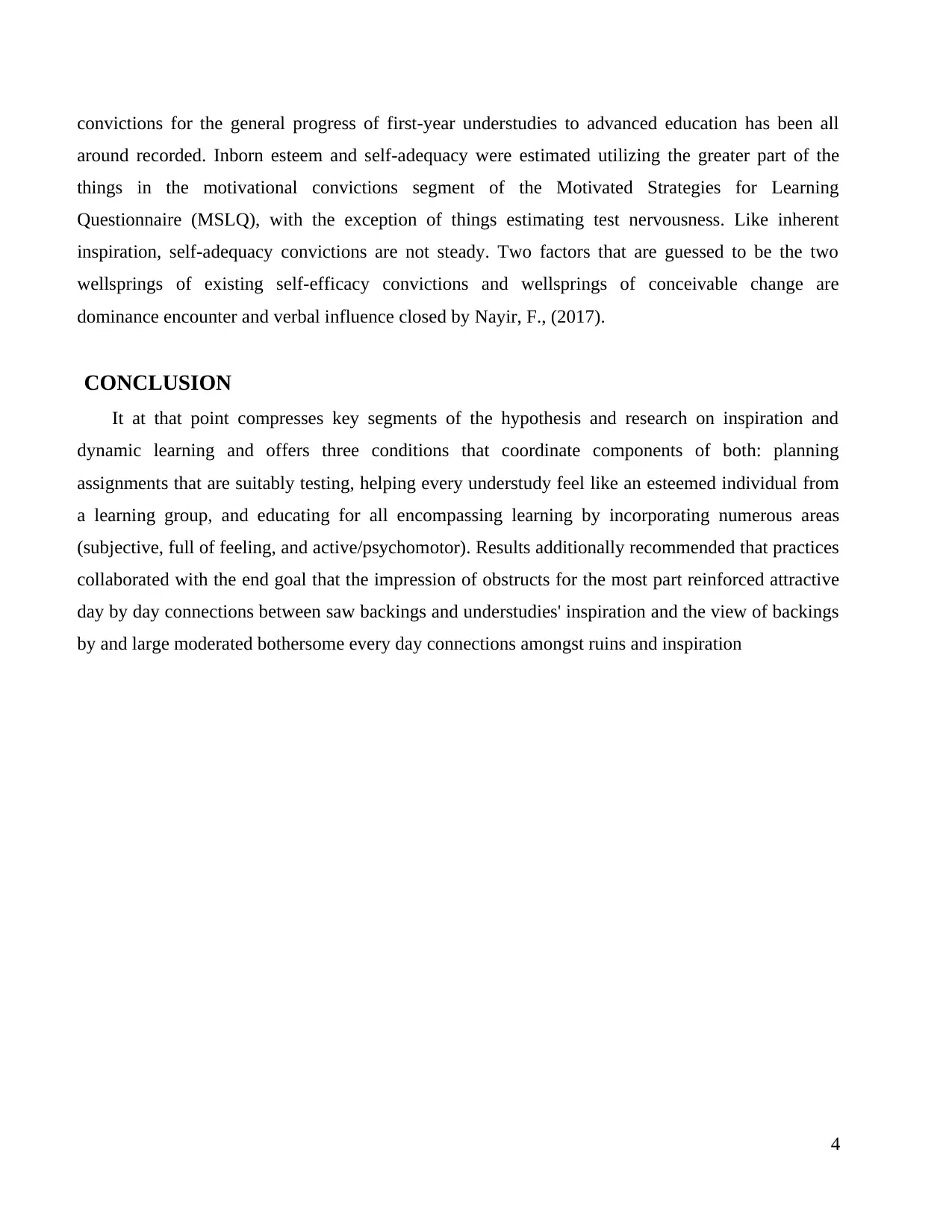
convictions for the general progress of first-year understudies to advanced education has been all
around recorded. Inborn esteem and self-adequacy were estimated utilizing the greater part of the
things in the motivational convictions segment of the Motivated Strategies for Learning
Questionnaire (MSLQ), with the exception of things estimating test nervousness. Like inherent
inspiration, self-adequacy convictions are not steady. Two factors that are guessed to be the two
wellsprings of existing self-efficacy convictions and wellsprings of conceivable change are
dominance encounter and verbal influence closed by Nayir, F., (2017).
CONCLUSION
It at that point compresses key segments of the hypothesis and research on inspiration and
dynamic learning and offers three conditions that coordinate components of both: planning
assignments that are suitably testing, helping every understudy feel like an esteemed individual from
a learning group, and educating for all encompassing learning by incorporating numerous areas
(subjective, full of feeling, and active/psychomotor). Results additionally recommended that practices
collaborated with the end goal that the impression of obstructs for the most part reinforced attractive
day by day connections between saw backings and understudies' inspiration and the view of backings
by and large moderated bothersome every day connections amongst ruins and inspiration
4
around recorded. Inborn esteem and self-adequacy were estimated utilizing the greater part of the
things in the motivational convictions segment of the Motivated Strategies for Learning
Questionnaire (MSLQ), with the exception of things estimating test nervousness. Like inherent
inspiration, self-adequacy convictions are not steady. Two factors that are guessed to be the two
wellsprings of existing self-efficacy convictions and wellsprings of conceivable change are
dominance encounter and verbal influence closed by Nayir, F., (2017).
CONCLUSION
It at that point compresses key segments of the hypothesis and research on inspiration and
dynamic learning and offers three conditions that coordinate components of both: planning
assignments that are suitably testing, helping every understudy feel like an esteemed individual from
a learning group, and educating for all encompassing learning by incorporating numerous areas
(subjective, full of feeling, and active/psychomotor). Results additionally recommended that practices
collaborated with the end goal that the impression of obstructs for the most part reinforced attractive
day by day connections between saw backings and understudies' inspiration and the view of backings
by and large moderated bothersome every day connections amongst ruins and inspiration
4
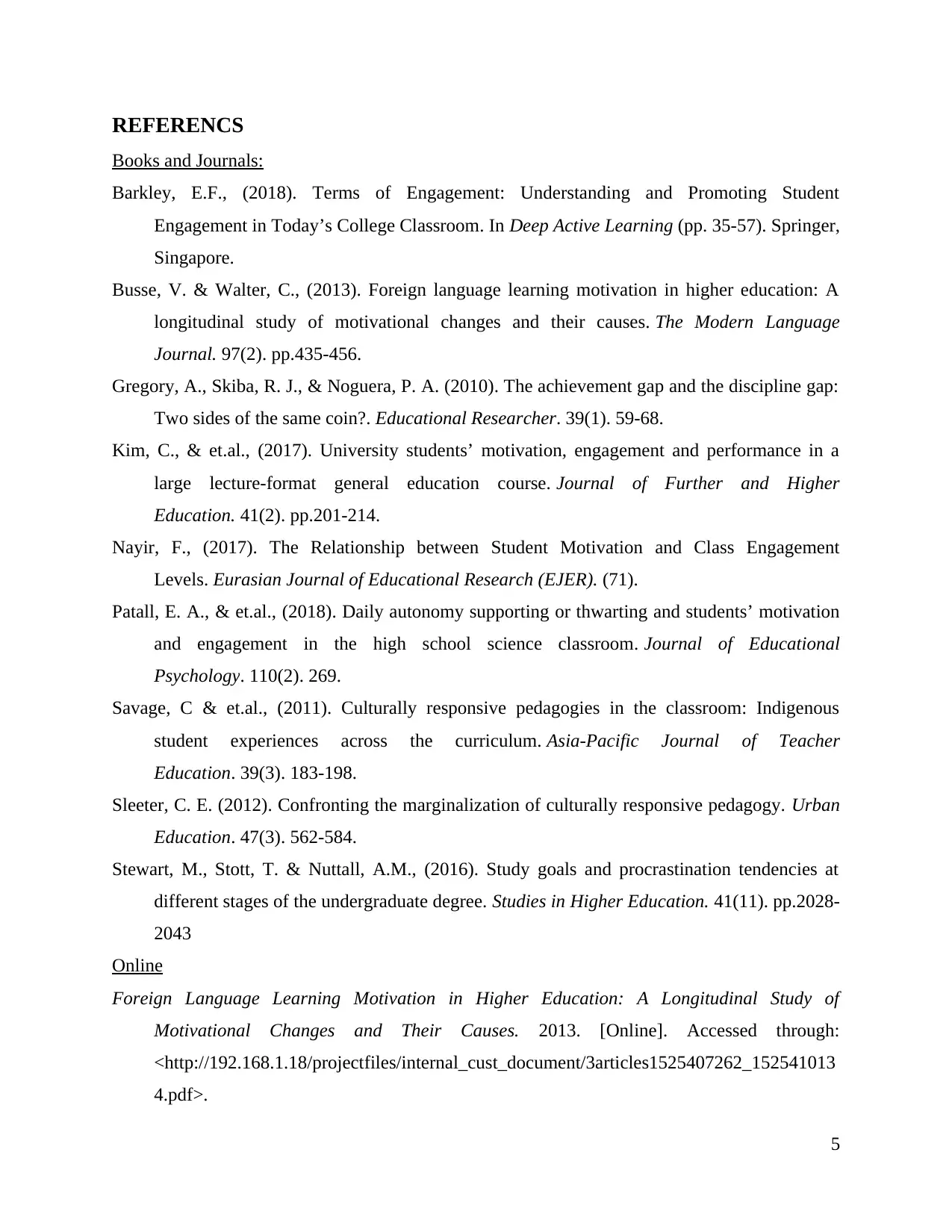
REFERENCS
Books and Journals:
Barkley, E.F., (2018). Terms of Engagement: Understanding and Promoting Student
Engagement in Today’s College Classroom. In Deep Active Learning (pp. 35-57). Springer,
Singapore.
Busse, V. & Walter, C., (2013). Foreign language learning motivation in higher education: A
longitudinal study of motivational changes and their causes. The Modern Language
Journal. 97(2). pp.435-456.
Gregory, A., Skiba, R. J., & Noguera, P. A. (2010). The achievement gap and the discipline gap:
Two sides of the same coin?. Educational Researcher. 39(1). 59-68.
Kim, C., & et.al., (2017). University students’ motivation, engagement and performance in a
large lecture-format general education course. Journal of Further and Higher
Education. 41(2). pp.201-214.
Nayir, F., (2017). The Relationship between Student Motivation and Class Engagement
Levels. Eurasian Journal of Educational Research (EJER). (71).
Patall, E. A., & et.al., (2018). Daily autonomy supporting or thwarting and students’ motivation
and engagement in the high school science classroom. Journal of Educational
Psychology. 110(2). 269.
Savage, C & et.al., (2011). Culturally responsive pedagogies in the classroom: Indigenous
student experiences across the curriculum. Asia-Pacific Journal of Teacher
Education. 39(3). 183-198.
Sleeter, C. E. (2012). Confronting the marginalization of culturally responsive pedagogy. Urban
Education. 47(3). 562-584.
Stewart, M., Stott, T. & Nuttall, A.M., (2016). Study goals and procrastination tendencies at
different stages of the undergraduate degree. Studies in Higher Education. 41(11). pp.2028-
2043
Online
Foreign Language Learning Motivation in Higher Education: A Longitudinal Study of
Motivational Changes and Their Causes. 2013. [Online]. Accessed through:
<http://192.168.1.18/projectfiles/internal_cust_document/3articles1525407262_152541013
4.pdf>.
5
Books and Journals:
Barkley, E.F., (2018). Terms of Engagement: Understanding and Promoting Student
Engagement in Today’s College Classroom. In Deep Active Learning (pp. 35-57). Springer,
Singapore.
Busse, V. & Walter, C., (2013). Foreign language learning motivation in higher education: A
longitudinal study of motivational changes and their causes. The Modern Language
Journal. 97(2). pp.435-456.
Gregory, A., Skiba, R. J., & Noguera, P. A. (2010). The achievement gap and the discipline gap:
Two sides of the same coin?. Educational Researcher. 39(1). 59-68.
Kim, C., & et.al., (2017). University students’ motivation, engagement and performance in a
large lecture-format general education course. Journal of Further and Higher
Education. 41(2). pp.201-214.
Nayir, F., (2017). The Relationship between Student Motivation and Class Engagement
Levels. Eurasian Journal of Educational Research (EJER). (71).
Patall, E. A., & et.al., (2018). Daily autonomy supporting or thwarting and students’ motivation
and engagement in the high school science classroom. Journal of Educational
Psychology. 110(2). 269.
Savage, C & et.al., (2011). Culturally responsive pedagogies in the classroom: Indigenous
student experiences across the curriculum. Asia-Pacific Journal of Teacher
Education. 39(3). 183-198.
Sleeter, C. E. (2012). Confronting the marginalization of culturally responsive pedagogy. Urban
Education. 47(3). 562-584.
Stewart, M., Stott, T. & Nuttall, A.M., (2016). Study goals and procrastination tendencies at
different stages of the undergraduate degree. Studies in Higher Education. 41(11). pp.2028-
2043
Online
Foreign Language Learning Motivation in Higher Education: A Longitudinal Study of
Motivational Changes and Their Causes. 2013. [Online]. Accessed through:
<http://192.168.1.18/projectfiles/internal_cust_document/3articles1525407262_152541013
4.pdf>.
5
Paraphrase This Document
Need a fresh take? Get an instant paraphrase of this document with our AI Paraphraser
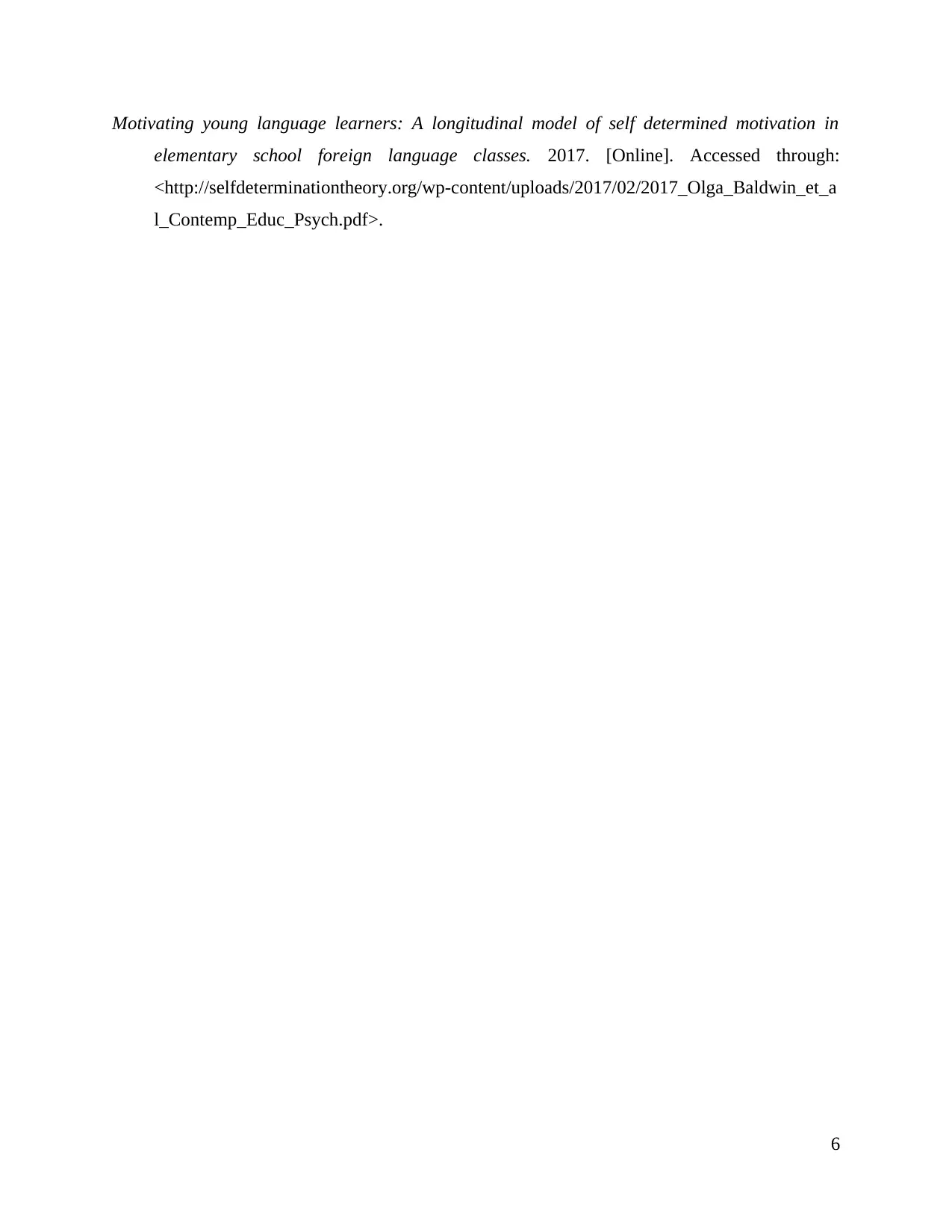
Motivating young language learners: A longitudinal model of self determined motivation in
elementary school foreign language classes. 2017. [Online]. Accessed through:
<http://selfdeterminationtheory.org/wp-content/uploads/2017/02/2017_Olga_Baldwin_et_a
l_Contemp_Educ_Psych.pdf>.
6
elementary school foreign language classes. 2017. [Online]. Accessed through:
<http://selfdeterminationtheory.org/wp-content/uploads/2017/02/2017_Olga_Baldwin_et_a
l_Contemp_Educ_Psych.pdf>.
6
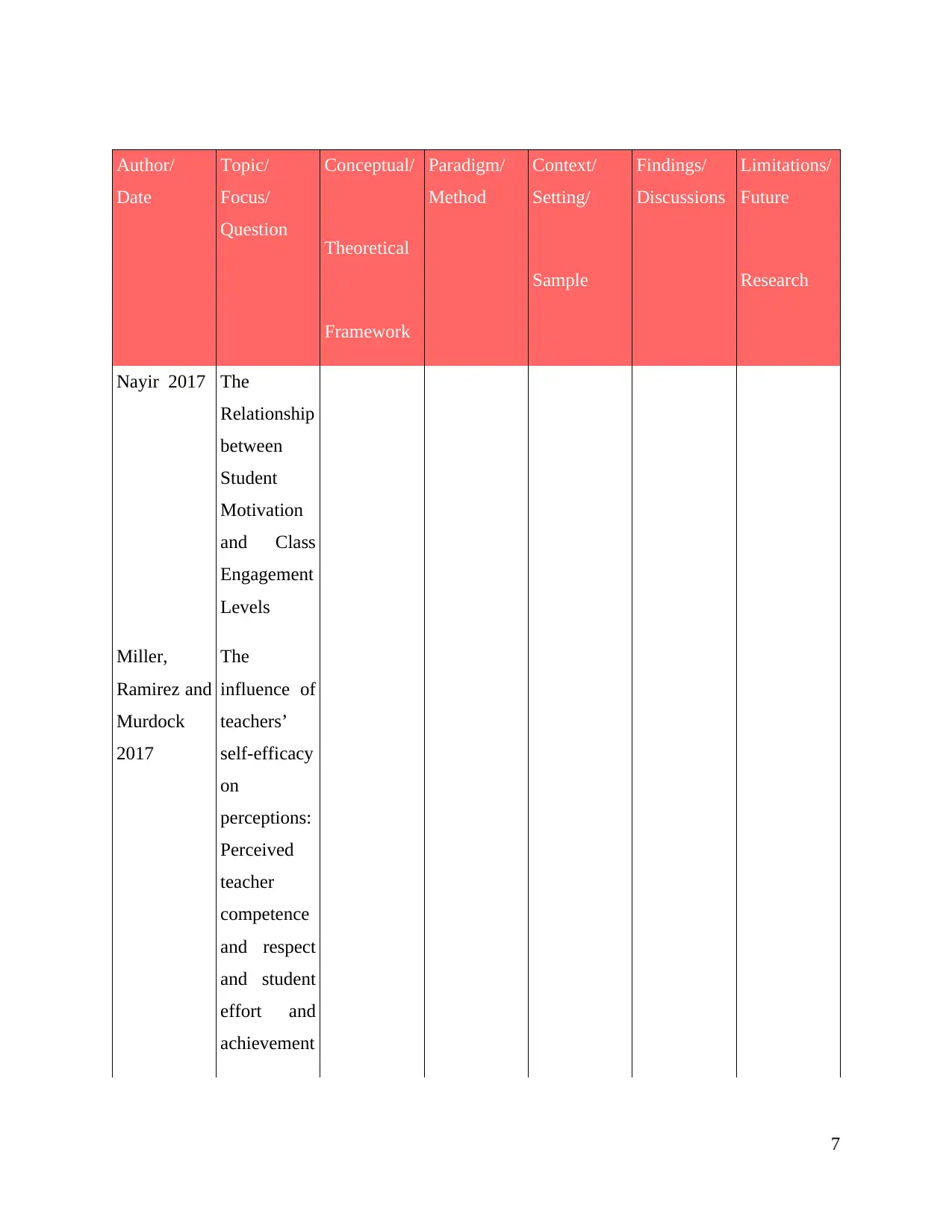
APPENDIX
Author/
Date
Topic/
Focus/
Question
Conceptual/
Theoretical
Framework
Paradigm/
Method
Context/
Setting/
Sample
Findings/
Discussions
Limitations/
Future
Research
Nayir 2017 The
Relationship
between
Student
Motivation
and Class
Engagement
Levels
Miller,
Ramirez and
Murdock
2017
The
influence of
teachers’
self-efficacy
on
perceptions:
Perceived
teacher
competence
and respect
and student
effort and
achievement
7
Author/
Date
Topic/
Focus/
Question
Conceptual/
Theoretical
Framework
Paradigm/
Method
Context/
Setting/
Sample
Findings/
Discussions
Limitations/
Future
Research
Nayir 2017 The
Relationship
between
Student
Motivation
and Class
Engagement
Levels
Miller,
Ramirez and
Murdock
2017
The
influence of
teachers’
self-efficacy
on
perceptions:
Perceived
teacher
competence
and respect
and student
effort and
achievement
7
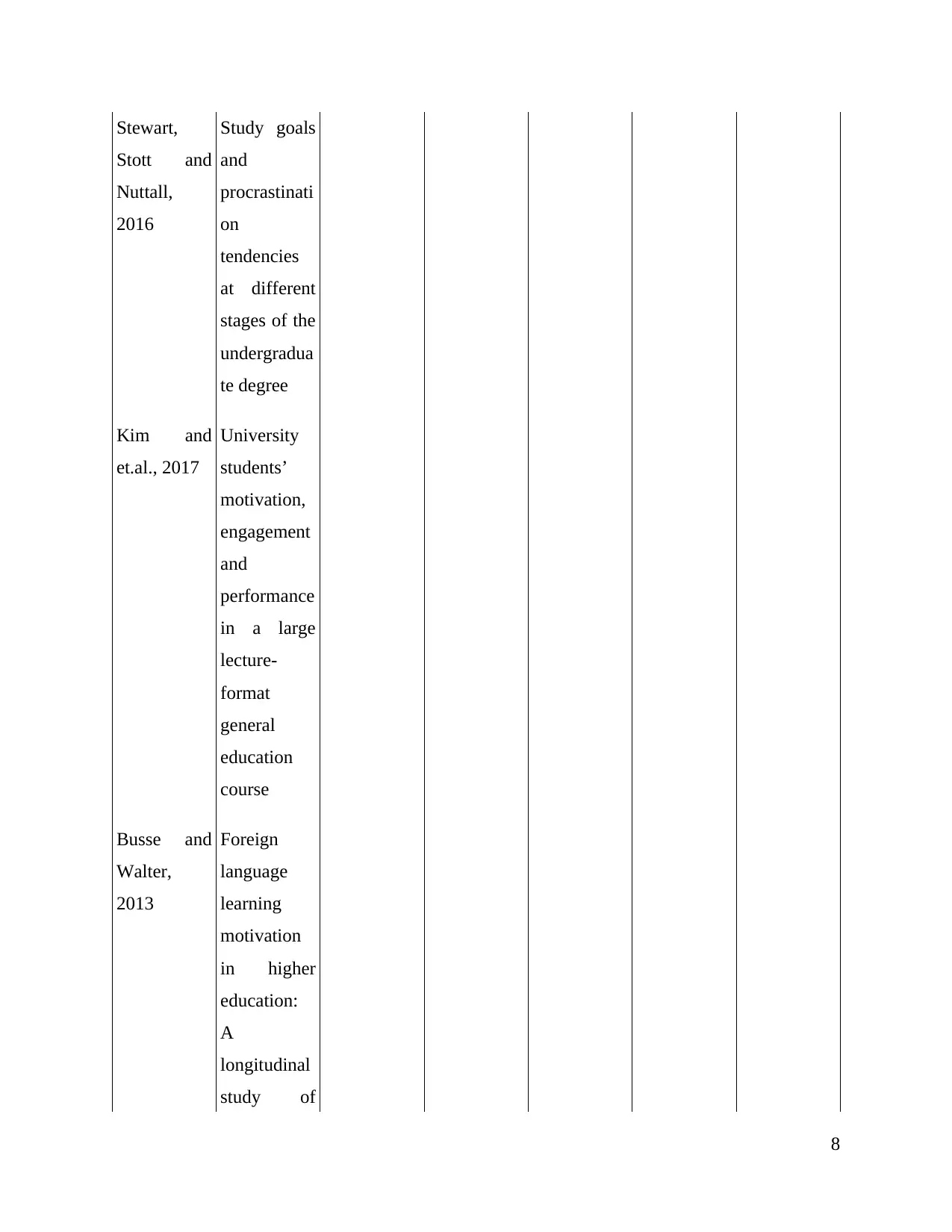
Stewart,
Stott and
Nuttall,
2016
Study goals
and
procrastinati
on
tendencies
at different
stages of the
undergradua
te degree
Kim and
et.al., 2017
University
students’
motivation,
engagement
and
performance
in a large
lecture-
format
general
education
course
Busse and
Walter,
2013
Foreign
language
learning
motivation
in higher
education:
A
longitudinal
study of
8
Stott and
Nuttall,
2016
Study goals
and
procrastinati
on
tendencies
at different
stages of the
undergradua
te degree
Kim and
et.al., 2017
University
students’
motivation,
engagement
and
performance
in a large
lecture-
format
general
education
course
Busse and
Walter,
2013
Foreign
language
learning
motivation
in higher
education:
A
longitudinal
study of
8
Secure Best Marks with AI Grader
Need help grading? Try our AI Grader for instant feedback on your assignments.
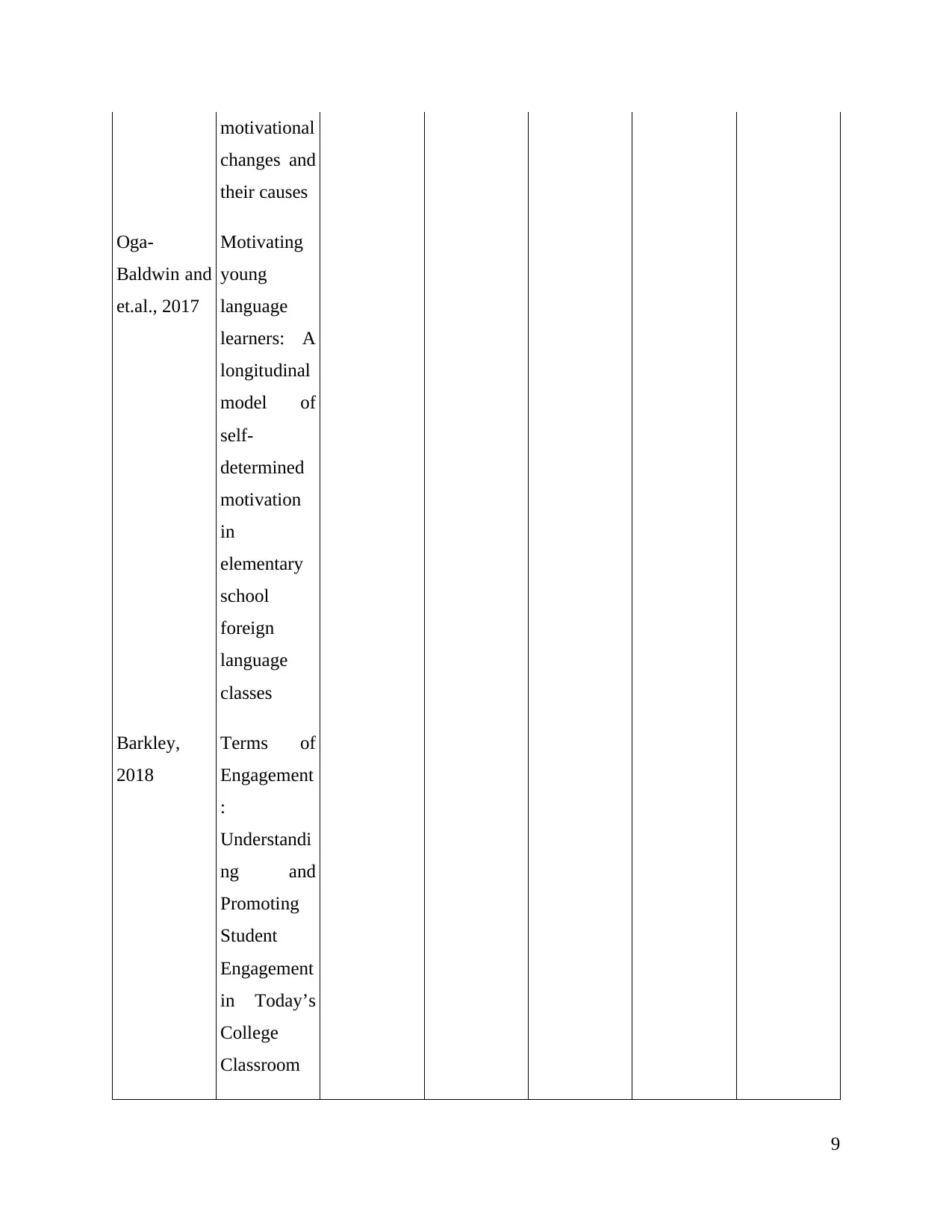
motivational
changes and
their causes
Oga-
Baldwin and
et.al., 2017
Motivating
young
language
learners: A
longitudinal
model of
self-
determined
motivation
in
elementary
school
foreign
language
classes
Barkley,
2018
Terms of
Engagement
:
Understandi
ng and
Promoting
Student
Engagement
in Today’s
College
Classroom
9
changes and
their causes
Oga-
Baldwin and
et.al., 2017
Motivating
young
language
learners: A
longitudinal
model of
self-
determined
motivation
in
elementary
school
foreign
language
classes
Barkley,
2018
Terms of
Engagement
:
Understandi
ng and
Promoting
Student
Engagement
in Today’s
College
Classroom
9
1 out of 11
Related Documents
Your All-in-One AI-Powered Toolkit for Academic Success.
+13062052269
info@desklib.com
Available 24*7 on WhatsApp / Email
![[object Object]](/_next/static/media/star-bottom.7253800d.svg)
Unlock your academic potential
© 2024 | Zucol Services PVT LTD | All rights reserved.





